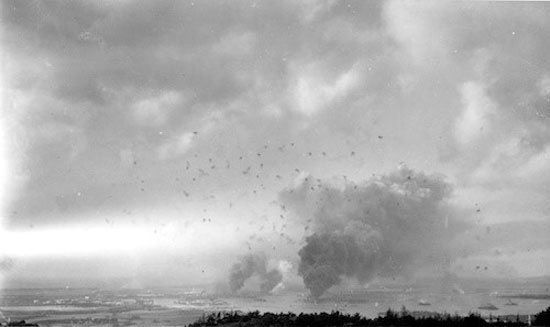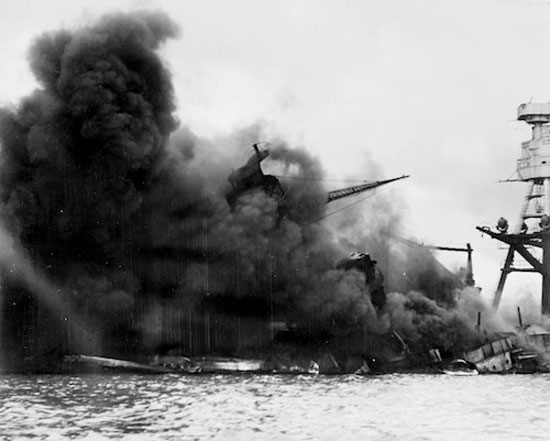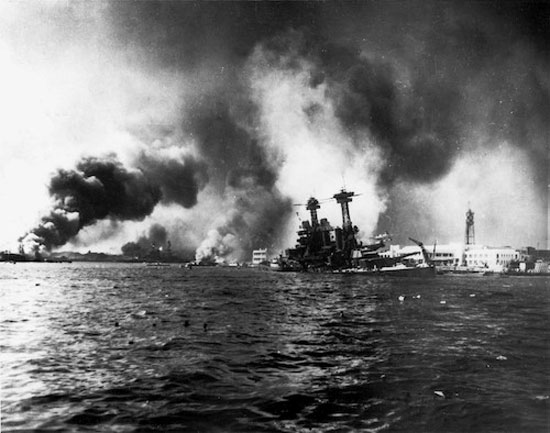Pearl Harbor False Flag: Time to Admit the Deception

Panorama view of Pearl Harbor, during the Japanese raid, with anti-aircraft shell bursts overhead
The Pearl Harbor false flag operation of December 7th, 1941 which provided the excuse for the US to enter World War 2 is about to be celebrated once again. This December 7th, 2017 will be the Pearl Harbor 76th Anniversary event. The horrific event was yet another in a long line of false flag operations that have been carried out by unscrupulous criminals (our misleaders) over the years. Just as with the 9/11 false flag attack, around 3,000 American lives were sacrificed so that the US Government had the pretext they needed to go to war. As the anniversary approaches, it is appropriate to cast our gaze back in time and set the record straight on the Pearl Harbor false flag op in the hope that this information will spread far and wide, and prevent future leaders from using this hackneyed tactic to trick people into submission and achieve their dark political and geopolitical goals.
The Pearl Harbor False Flag Motive: Providing a “Legitimate” Cover Story for the Long-Planned Entry of the US into WW2
To begin with, the Pearl Harbor attack is not a false flag op in the sense that the US attacked in its own ships and planes. It is a false flag in the sense that at the very least Roosevelt let it happen, and as the evidence will show, he made it happen. Most of the US Pacific fleet of planes and ships were intentionally left there as sitting ducks with no air protection, an easy target for the Japanese torpedo planes. The Japanese managed to destroy nearly 20 American naval vessels, including 8 massive battleships and over 300 airplanes.
The “surprise” attack proved to be an easy excuse for Roosevelt to convince the American people and Congress to enter WW2. (Yep, those were the days when the US President actually followed the Constitution more – although Roosevelt was still a criminal of course for his actions here – unlike Obama who has tried throughout his 8-year tenure to go to war without Congressional approval.) After all, who would begrudge a nation declaring war on another nation, after the former had been attacked for no apparent reason? The collective mindset 75 years ago was quite different from today. People trusted their leaders more; people were more patriotic and nationalistic; and there was no internet or easy way for people to “fact check” their leaders to tell if they were lying or not.

Pearl Harbor false flag: the USS Arizona is attacked by Japanese bombers.
Bankers’ Wars
Before we examine the evidence that Roosevelt knew full well that Pearl Harbor was going to happen, we need to consider how wars are really run. Wars occur on the surface between nations, but really, it is the dark force of the international banking cabal that pulls the strings behind the scenes to aggravate opposing sides, instigate tension and encourage conflict. Then it funds both sides to ensure there is a war, and can often decide the outcome of the war by choosing which side to fund more heavily.
Mark Twain observed that while history may not repeat itself, it sure does rhyme. A similar type of false flag operation also occurred during WW1, when Germany sank the British Lusitania ship (which was carrying munitions) on its way from New York to England. There was foreknowledge – the German embassy in the US had placed an advertisement in the newspaper warning people that sailing on the Lusitania could be dangerous. Even the biased and controlled Wikipedia admits: “The sinking caused a storm of protest in the United States, however, as 128 American citizens were among the dead. The sinking helped shift public opinion in the United States against Germany, and was a factor in the United States’ declaration of war nearly two years later.”
Woodrow Wilson assured the population that the US would not enter WW1, and was elected partly on the basis of that pre-election promise, but when Americans were killed, what was he supposed to do? Ditto for Roosevelt. Same old scam. History rhymes.
The Pearl Harbor False Flag Op: 3 Conspiracies
Turning now to Pearl Harbor false flag event itself, some of the best information can be found in the book Day of Deceit by author Robert Stinnett, who served in the US Navy during WW2. His research includes declassified documents which were withheld from the American public for over 60 years. Stinnett’s work shows that there were really three conspiracies surrounding the event: the first was to induce Japan to attack America and thus provide an unbeatable pretext for America to enter World War 2; the second was to deprive the Pearl Harbor commanders of available information about Japan’s intentions; and the third was to ensure that all evidence of foreknowledge will always be kept away from the public.
Conspiracy #1: Coaxing Japan into Attacking
Stinnett includes a memorandum that he obtained under Freedom of Information Act by Japanese expert Captain Arthur McCollum, chief of the Far Eastern Section of Naval Intelligence, dated October 7, 1940. This nefarious McCollum memo listed an 8-point plan to induce Japan “to commit an overt act of war”. In an interview in 2002, Stinnett was asked whether Franklin D. Roosevelt saw the memo. He replied: “There’s no proof that he actually saw the memorandum, but he adopted all eight of the provocations – including where he signed executive orders… And other information in Navy files offers conclusive evidence that he did see it.”
Here are the eight points McCollum advocated, all of which Roosevelt performed or arranged (some over the objections of Commander-in-chief of the US fleet James Richardson):
A. Make an arrangement with Britain for the use of British bases in the Pacific, particularly Singapore.
B. Make an arrangement with Holland for the use of base facilities and acquisition of supplies in the Dutch East Indies.
C. Give all possible aid to the Chinese government of Chiang-Kai-Shek.
D. Send a division of long range heavy cruisers to the Orient, Philippines, or Singapore.
E. Send two divisions of submarines to the Orient.
F. Keep the main strength of the U.S. fleet now in the Pacific in the vicinity of the Hawaiian Islands.
G. Insist that the Dutch refuse to grant Japanese demands for undue economic concessions, particularly oil.
H. Completely embargo all U.S. trade with Japan, in collaboration with a similar embargo imposed by the British Empire.
Point F is highly significant, because it allowed the Japanese to destroy a major part of the US fleet, thus maximizing the injury in the public’s perception – which was after all the ultimate target that day. In addition to coaxing the attack in many ways, the US also allowed a Japanese naval spy carte blanche to spy on the base at Pearl Harbor and transmit information back to Japan in preparation for the attack.

Pearl Harbor false flag: the USS California sinks
Conspiracy #2: Crack the Japanese Code but Keep Them in the Dark
Remember the good old mushroom modus operandi? Feed them useless info and keep them in the dark? That’s what went on with the Pearl Harbor commanders, Admiral Kimmel (Commander in Chief of the US Fleet) and Lt. General Short (head of the US Army Defenses at Pearl Harbor), who were denied the critical information they needed to prepare for and defend against the attack.
According to Stinnett, US cryptographers had deciphered Japan’s diplomatic code (known as MAGIC). They had also deciphered some of Japan’s military codes, which meant that they could understand the messages they were intercepting in the Pacific. The significant information that was received from these intercepts (such as the Japanese Task Force’s last-minute choice for its staging area, its destination and its attack order) was deliberately withheld from Kimmel and Short.
Around two weeks before the attack occurred (on November 23, 1941) Kimmel had ordered (without White House approval) a search for Japanese forces north of Hawaii. He had actually moved the fleet into the North Pacific. However, once White House officials learned of this, they ordered the ships back to Pearl Harbor. Another piece of evidence is that on November 25, the Navy headquarters in Washington ordered Kimmel to route all transpacific shipping southward leaving the north Pacific conveniently open, allowing Japan to attack with no intervening vessels.
Conspiracy #3: Evidence of Foreknowledge
There is a considerable amount of foreknowledge, in addition to the points above. Here are some more examples:
– Roosevelt wanted to “win the war together” with England. As James Perloff writes:
“Roosevelt dispatched his closest advisor, Harry Hopkins, to meet British Prime Minister Winston Churchill in January 1941. Hopkins told Churchill: ‘The President is determined that we [the United States and England] shall win the war together…’
Roosevelt’s intentions were nearly exposed in 1940 when Tyler Kent, a code clerk at the U.S. embassy in London, discovered secret dispatches between Roosevelt and Churchill. These revealed that Roosevelt – despite contrary campaign promises – was determined to engage America in the war. Kent smuggled some of the documents out of the embassy, hoping to alert the American public, but was caught.”
– On November 25th, 1941, Roosevelt received a “positive war warning” from Churchill that the Japanese would strike against America at the end of the first week in December. This warning caused the President to do an abrupt about-face on plans for a time-buying modus vivendi with Japan and it resulted in Secretary of State Hull’s deliberately provocative ultimatum of November 26th, 1941, that guaranteed war.
– On November 26th, 1941, Washington ordered both US aircraft carriers, the Enterprise and the Lexington, out of Pearl Harbor “as soon as possible”. This order included stripping Pearl of 50 planes or 40% of its already inadequate fighter protection. On the same day Cordell Hull issued his ultimatum demanding full Japanese withdrawal from Indochina and all China. The US Ambassador to Japan called this “the document that touched the button that started the war”.
– On November 29th, 1941, Hull told United Press reporter Joe Leib that Pearl Harbor would be attacked on December 7. The New York Times reported on December 8th (Attack Was Expected, p. 13) that the US knew of the attack a week earlier.
– On December 1st, 1941, the Office of Naval Intelligence (ONI) 12th Naval District in San Francisco found the missing Japanese fleet by correlating reports from the four wireless news services and several shipping companies that they were getting signals west of Hawaii.
– On December 5th, 1941, Roosevelt wrote to the Australian Prime Minister: “There is always the Japanese to consider. Perhaps the next four or five days will decide the matters.”
– Stinnett also notes that it was reported that before the bombing occurred, newspapers were delivered the details of the attack.
Conclusion: Spread the Truth about the Pearl Harbor False Flag Operation
So, as the Pearl Harbor anniversary approaches, approach it from an informed perspective. Those 3,000 Americans died for a lie. Just as with 9/11, thousands of American lives were sacrificed so the US criminal elite had an excuse to go to war. The US was worried by industrial and military strength of Nazi Germany and needed a backdoor way to enter the war against Germany. Staging a Pearl Harbor false flag op was the only way, leading officials to galvanize the reluctant American public into action.
Pearl Harbor was a carefully orchestrated plot adopted by US President Franklin Roosevelt to lure Japan into attacking and starting a war with the US. It’s time for everyone to know the truth.
yogaesoteric
October 25, 2017
